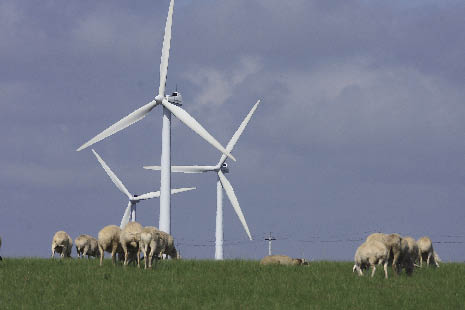|
Concerted Participation
High-density carbon dioxide is being released from containers to cover a wheat plot 30 kilometers north of Beijing. This is the research lot of Lin Erda and his colleagues at the Chinese Academy of Agricultural Sciences. The purpose of their experiment is to simulate the carbon dioxide situation in the atmosphere 40 years from now, to measure the impact on wheat growth and to acquire the necessary data for the establishment of a long-term agricultural production mechanism able to withstand future natural disasters. More experiments of a similar nature are being conducted in national labs in the hope of finding an effective solution to climate change.
 |
|
From 2000 to 2008, China's wind power capacity increased from 340,000 kW to 10 million kW. |
The environmental and energy problems that have unfolded in developed countries over the past 200 years have come to the fore within a much shorter timeframe in China. Developed countries have spent decades tackling these problems, but China is pressed for a quick solution. The challenge is monumentally difficult, said Premier Wen Jiabao at a forum about climate change technology development and transfers.
According to statistics from the International Energy Agency, China's energy consumption per unit of GDP is 4.3 times that of the United States, and 6.5 times that of the U.K. Compared with the average level of energy consumption in developed countries, every ton of cement produced in China costs 43 percent more, every ton of crude oil 56 percent more, and thermal power generation 22 percent more. Energy-saving and emissions reduction is consequently a tough challenge for China.
Experts and the government agree that more efforts should be made in the areas of technological innovation and the development of new forms of energy. Between 2000 and 2008, China's installed wind generating capacity increased from 0.34 million KW to 10 million KW, its hydropower generation capacity from 79.35 million KW to 163 million KW, and its nuclear generation capacity from 2.1 million KW to 8.85 million KW. In 2007 alone, China shut small thermal power generation units totaling 14.38 million KW of capacity. In addition, China closed down over 10,000 small coalmines, plus many iron, steel and cement factories using outmoded production methods, taking out 46.59 million tons of production capacity for iron, 37.47 million tons for steel, and 52 million tons for cement. Closing down these small enterprises, according to Lin Erda, was a painful act, because though they were high energy consumers, they all contributed to local economies and provided employment.
Using science and technology to support environmental protection and cope with climate change has been a key task of China's Science and Technology Ministry. For this purpose, the investments in the first group of such projects during the Eleventh Five-year Plan (2007-2012) were up to RMB 5 billion, double the figure of the previous plan period. Vice Minister of Science and Technology Shang Yong admits there are huge economic pressures to put environmental protection technology and products to practical use, and to research and develop environmentally friendly vehicles. Much remains to be done before these products are affordable for consumers.
"A large amount of money is to be spent in a short period," says Li Yan, "but in the long run, we have to find a healthy and sustainable development mode for the progress of the Chinese economy. High costs still bind the hands and feet of a developing country like China in coping with climate change. This is why the Chinese government has made repeated efforts on various occasions to call on developed countries for the elimination of the high threshold for technology transfer and for more economic support.
"In spite of these hindrances," says Li Yan, "China is currently leading the U.S. in environmental measures by setting higher requirements for vehicle exhaust emissions and the energy efficiency of thermal power generation. However, most of the measures that have been adopted for energy saving are governmental, and more administrative than economic and market-regulated." Xie Zhenhua, vice minister of China's Development and Reform Commission, revealed that the government was planning to adjust the price structure of energy resources with the aim of economizing resources and enforcing environmental protection.
More and more non-governmental efforts have also been seen. Since its founding in 2007, China's Green Carbon Fund (CGCF) has accepted donations from many individuals and groups. One of their campaigns was conducted simultaneously in Beijing and Inner Mongolia, aiming to assist the recovery of local forest ecosystems, thereby increasing forests' ability to absorb and store carbon dioxide.
To many environmentalists, the Beijing Olympics provided a wonderful opportunity for public participation. The limiting of motor vehicle usage during the Olympic Games won support from Beijingers, and significantly reduced exhaust emissions. As a result, Beijing's air quality improved noticeably. After the Games, more cities joined Beijing in limiting the use of motor vehicles through forcing each car off the road one day a week, based on the last digit of license plates.
|
